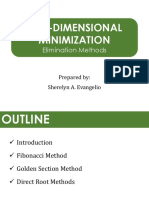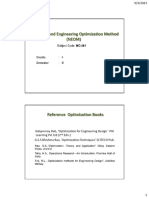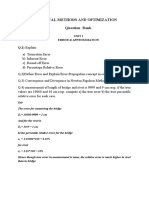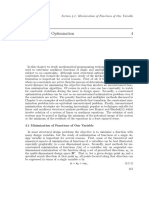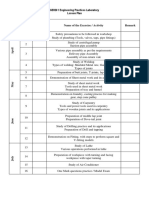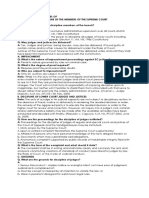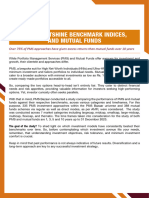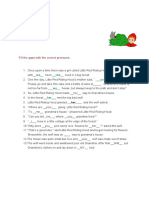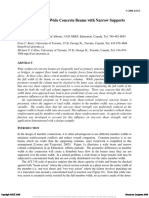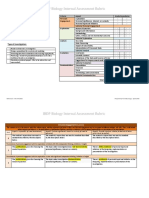Unit 1
PART - A
1. State the necessary and sufficient conditions for the Maximum of a multi variable
function f(X).
2. Define a saddle point and indicate its significance.
3. How do you test the Positive, Negative and Indefiniteness of a Square
Matrix [A]?
4. Find the Maximum of a function f (X) = 2x1 + x2 +10 subject to g(X) = x1 + 2x22 = 3
using Lagrange multiplier method.
5. For a problem of two variables with one constraint, explain the method of finding
solution by Lagrange multiplier method.
6. Define the following:
(i)
Feasible solution
(ii)
Basic solution
(iii)
Basic feasible solution
(iv)
Non degenerative Basic feasible solution
(v)
Optimal Basic solution.
7. Define degeneracy and cycling in a Simplex Problem and explain the method to
resolve the degeneracy.
8. What is the need for Artificial variable Technique? List the disadvantage of
Big - M method over Two-Phase method.
PART - B
1. (i) Determine the maximum and minimum value of the function
f(x) = 12x5 45 x4 + 40x3 + 5
(ii) Minimize f(x, y) = k/(xy2)
subject to
g(x, y) = x2 + y2- a2 = 0 using Lagrange multiplier method.
2. Maximize z = x1 + 2x2 + x3
subject to the constraints
2x1 + x2 - x3 2
-2x1 + x2 - 5x3 - 6
4x1 + x2 + x3 6
xi 0 i = 1, 2, 3
�using simplex method
3. Use the simplex method to solve the LPP
Maximize z = 3x1 + 5x2
subject to the constraints
x1 + 2x2 2000
2x1 + x2 2000
x2 600 and
x1, x2 0
4. Use the simplex method to solve the LPP
Minimize z = -x1 + x2 - 3x3
subject to the constraints
x1 + x2 + x3 10
- 2x1 + x3 - 2
2x1 - 2x2 + 3x3 0 and
x1, x2, x3 0
5. Use Big - M to
Minimize z = 4x1 + x2
subject to the constraints
3x1 + x2 = 3
4x1 + 3x2 6
x1+ 2x2 3
x1, x2 0
6. Use two phase simplex method to
Minimize z = 2x1 + 3x2 + 2x3 - x4 + x5
subject to the constraints
3x1 - 3x2 + 4x3 + 2x4 - x5 = 0
x1 + x2 + x3+3x4 + x5 = 2
xi 0
i = 1 to 5
�UNIT- II
PART - A
1. (i) What is an one-dimensional minimization problem?
(ii) What are the limitations of classical methods in solving a one- dimensional
minimization problem?
2. List out various one dimensional minimization methods
3. Write the search Algorithm with a fixed step size to find the minimum of a
function.
4. Explain Exhaustive algorithm used to find minimum of a function.
5. (i) What is the difference between Fibonacci and golden section methods?
(ii) List out the limitations of Fibonacci method
6. Explain the Fibonacci method to find the minimum of an one variable function
7. Explain the golden section method to find the minimum of a function
8. Compare various Elimination methods viz, Exhaustive search, Dichotomous
search, Fibonacci and golden section methods.
PRAT - B
1. Minimize f(x) = 0.65 [0.75 / (1+ x2 )] 0.65 (x tan-1(1/x)) in the interval [0,3] by
the Fibonacci method using n = 6
2. Find the minimum of the function f =
- 53 - 20 + 5 by Exhaustive search in
the interval (0,5).
3. Minimize f(x) = x (x - 1.5) in the interval (0,1) by Golden section method using
n = 7.
4. Find the maximum of the function
f() = 1/ [ 2(1+2 )1/2 ] - (1+2 )1/2 (1- (1/ [ 2(1+2 ) ] ) ) + using Newton method
with staring point 0.6
5. Minimize f(x) = x + 4/x using Fibonacci search in the interval (0,2) using n = 6
6.
Find the minimum of f = x + 4x -1 in the interval (0, 2) to within 10 % of the exact
value.
�UNTI - III
PART - A
1. (i) State the necessary and sufficient conditions for the unconstrained minimum
of a function
(ii) Give three reasons why the study of unconstrained minimization is important.
2. Explain with a flowchart, the iterative procedure used in unconstrained
optimization.
3. Explain univariate method in finding the minimum of a function.
4. Explain the Random walk method in detail
5. Explain Hooke and Jeeves methods of pattern search.
6. Explain steepest descent method of unconstrained minimization.
7. State Fletcher -Reeves iterative procedure.
8. What is the role of one-dimensional minimization methods in solving an
unconstrained minimization problem?
PART - B
1. Minimize f = 2x12 + x22 with starting point (1, 2) using the univariate method.
2. Minimize f = 4x12 + 3x22 - 5x1x2 - 8x1 with starting point (0, 0) using Powells method
3. Minimize f = x12 + 3x22 + 6x32 by the Hooke-Jeeves method by taking
x1 = x2 = x3 = 0.5 and the staring point as (2,-1, 1)
4. Minimize f = 2x12 + x22 by using the steepest descent method with the staring
point (1, 2)
5. Minimize f(x1,x2) = x1 - x2 + 2x12 + 2x1x2 + x22 staring from the point (0, 0) taking x1
= x2 = 0.8 and
= 0.1 by Hooke and Jeeves method
6. Minimize f(x1, x2) = x1 - x2 + 2x12 +2x1x2 starting from the point (0, 0) using
Fletcher-Reeves method










